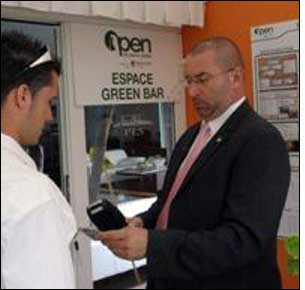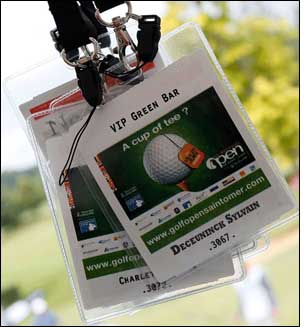Organizers of the Open de Saint-Omer, an annual golf tournament in northern France, deployed a passive radio frequency identification system at this year’s event to streamline access to special areas reserved for VIP guests.
The tournament, which took place June 15-21, was attended by more than 13,000 spectators, including 2,000 VIPs with special access to private boxes, VIP lounges, exhibitor areas, restaurants and hotels. An additional 1,000 people, including organizers, players, sponsors and journalists, also required special access rights. In some cases, an individual’s rights to visit various areas could vary from day to day, says Sandrine Grevet, director of golf development with Najeti France, the company that runs the tournament and golf resort.
“We’ve had a problem each year,” Grevet explains. “It was really, really difficult to ever say who can get into this part of the tournament, who can have lunch or who can get into the special Green Bar for VIPs.”
Previous approaches relied upon bar-coded badges and wristbands to control access, Grevet says, resulting in long lines and lower guest satisfaction. In addition, she notes, it was very difficult to build up a profile of guests and sponsors to track their preferences for future events.
For this year’s tournament, Najeti decided to adopt a passive RFID system to track VIPs at the event. The system was deployed with the assistance of NooliTIC, an RFID consultancy and systems integrator based in Lille, France.
Using six Psion Teklogix Workabout Pro S-G2 Gen 6 handheld computers with built-in RFID interrogators and an RFID ticketing solution supplied by Belgium-based RFIDEA, the technical team set up the system in three days. ID badges containing high-frequency (HF) 13.56 MHz passive tags, complying with the ISO 15693 standard, were issued to 3,000 guests, staff members and other individuals with special access rights, according to Gregory Marquis, NooliTIC’s co-founder.
The readers were linked by a wireless network and a Global Packet Radio System (GPRS) network operated by Orange, a French telecom company that was also a tournament sponsor. A centralized guest database provided by RFIDEA and adapted by NooliTIC managed the access rights of every individual using the system.
The centralized system also enabled organizers to quickly change a badge holder’s rights if that person required access to a different part of the tournament—unlike the old system, which would have required issuing a new identification badge or bracelet. According to Marquis, access rights for guests could be changed daily.
One of the greatest challenges implementing the system, Marquis indicates, involved making sure the guest database was accurate from the onset, in order to minimize confusion when guests begin utilizing the system. The data provided by the system allowed tournament organizers an unprecedented level of detail into how guests experienced the event.
“Last year, they had no statistics at all about how the customers were coming and going from the tournament,” Marquis states. “Now, we are able to give them figures in real time about how much time customers have spent in the various bars and restaurants.” This enabled the organizers to determine which locations were most popular with guests, in order to manage planning for next year’s tournament.
Due to European Union privacy regulations, tournament guests had the right to opt out of having their personal information collected. To give them an incentive to participate, the tournament offered a raffle with prizes for those who took part.
The cost of the entire project was €12,000 ($17,000), Marquis says, and some technical sponsors—like Orange and StoreData, a French data-storage firm—helped to finance the project. Two employees from NooliTIC and RFIDEA assisted in setting up the system, with one remaining on-hand throughout the tournament to provide support, though thanks to this year’s successful deployment, Marquis notes, that may not be necessary for future events.
Information collected from this year’s tournament is already having an impact on planning future events, Grevet says. A virtual-reality driving range at this year’s event turned out to have very few visitors, so resources can now be shifted from the simulator to other venues with higher traffic.
Overall, Grevet is extremely pleased with the tournament’s experience with RFID. Najeti France, she says, is already considering how to employ the technology in other applications. The resort operator has kept one RFID interrogator from the tournament and is using it at Saint-Omer’s clubhouse, so that tournament VIPs who attended the event can now sign in with their event ID badge to receive special discounts. This, she says, affords Najeti an opportunity to deepen its relationship with its customers.
“There’s no limit to what we can do with RFID,” Grevet states.



